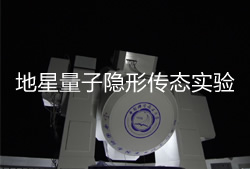Micius Satellite is one of the five scientific experimental satellites established by the Chinese Academy of Sciences in the field of strategic science and technology. It aims to setup a long-distance quantum science experiment platform for satellite and ground stations and complete the space-scale Quantum science experiment, in order to obtain breakthroughs in basic quantum physics research and a series of remarkable scientific results, and to make quantum communication technology application to longer distancein order to promote wide-area and even global quantum communication. At the same time, the project will provide a first-class testing and application platform for the continuous innovation and engineering problems of various key technologies and devices for wide area quantum communication, and promote technologies of space laser aiming, space weak light detection, space high precision synchronization, small satellite high-precision attitude maneuver, high-speed single photon detection, etc.
Quantum Science Experimental Satellite project develops and launches a quantum science experimental satellite, products a long march II rocket, and launch the satellite to a 500 km height orbit in Jiuquan Satellite Launch Center. While the project constructs four quantum communication ground stations and one space quantum teleportation experimental station as the core of the space-ground integrated quantum science experiment system to complete a series of world-leading scientific experiments.
The main scientific goals of the quantum science experiment satellite are: to carry out the space-to-ground high-speed quantum key distribution, and the wide-area quantum key network experiment in order to achieve a practical breakthrough in the application of space quantum communication; To carry out space-to-ground quantum entanglement distribution and ground-to-space quantum teleportation experiments in order to test the completeness of quantum mechanics at space scale.
Four Experiments
 |
 |
 |
 |
| With the help of the high-precision capture, tracking, targeting system, The experiment will realize the decoy-state quantum key distribution between the satellite and the ground, distribution, to achieve the satellite-to-ground absolutely secure communications based on the quantum key distribution. | Based on the realization of high-speed satellite-to-ground quantum key distribution, the experiment will adjacent two optical ground stations and to their two local fiber-optic quantum communication network, to form a wide-area quantum communication network through the satellite relay. | In this experiment, the satellite distributes the entangled photons to the two ground stations simultaneously, and performs independent quantum measurements of the entangled photons simultaneously, in order to test the completeness of quantum mechanics over 1000 km. | The experiment will explore the feasibility of quantum teleportation between the ground stations and the satellite with the help of quantum memory, and complete the experimental study of quantum mechanics non-localization under the space condition. |
Organization
- Spokesperson: Prof. Jian-Wei Pan (USTC)
- Chief scientist: Prof. Jian-Wei Pan (USTC)
- Chief engineer: Prof. Bo-Ming Xu (CASC)
- Vice chief engineer: Prof. Jian-Yu Wang (CAS)
Satellite System
The satellite system is responsible for the development of satellite platforms and payloads. The payloads includes quantum key communicators, quantum entanglement transmitters, quantum entanglement sources and quantum experimental control and processors.
- Chief designer: Prof. Zhen-Cai Zhu (SECM-CAS)
- Vice chief designer: Prof. Yi-Lin Zhou (SECM-CAS)
- Vice chief designer: Prof. Rong Shu (SITP-CAS)
- Vice chief designer: Prof. Cheng-Zhi Peng (USTC)
Scientific Application System
The scientific application system is responsible for the development of the scientific experiment plan of the whole quantum science experiment satellite engineering, the implementation of the scientific experiment, the processing and the management of the scientific data and application. The system configuration is: one center (Hefei Quantum Science Experimental Center), four quantum communication ground stations (Nanshan, Delingha, Xinglong, Lijiang), and one quantum teleportation platform (Ali).
- Chief designer: Prof. Cheng-Zhi Peng (USTC)
- Vice chief designer: Prof. Xiao-Jun Jiang (NAOC-CAS)
Related News
- “墨子号”实现基于纠缠的无中继千公里量子保密通信
- “墨子号”量子科学实验卫星成果获克利夫兰奖
- Chinese Study on Quantum Communication Wins Newcomb Cleveland Prize
- “墨子号”量子科学实验卫星洲际量子密钥分发成果入选美国物理学会2018年度国际物理学十大进展
- [Physics] Highlights of the Year
- [New York Times] The Race Is On to Protect Data From the Next Leap in Computers. And China Has the Lead
- [Wired Encryption]Why China's perfectly placed to be quantum computing's superpower
- [Phys.org]18-qubit entanglement sets new record
- [Physics World]Record-breaking entanglement uses photon polarization, position and orbital angular momentum
- [Physics]Viewpoint: Lost Photons Won’t Derail Quantum Sampling